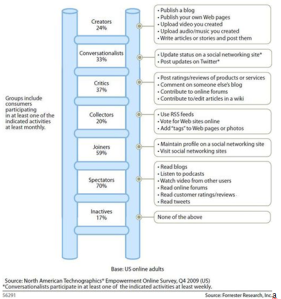 Nearing 2,200 members on the NSW DET Yammer community its undoubtedly the most subscribed (and active) professional online network in NSW DET. So I thought it might be timely to look at emerging patterns of use and engagement. Sampling the past week of activity (which was taken to be typical), there is clear group of regular contributors, with the majority relegated to either ‘joiners’, or ‘lurkers’. Last week for instance we had on average 35-45 unique ‘contributors’ daily, and for the entire week this panned out to be (generously) around 70 . That’s a large imbalance. This ratio can be seen increasing since this community started in December 2009 (earlier?).
Nearing 2,200 members on the NSW DET Yammer community its undoubtedly the most subscribed (and active) professional online network in NSW DET. So I thought it might be timely to look at emerging patterns of use and engagement. Sampling the past week of activity (which was taken to be typical), there is clear group of regular contributors, with the majority relegated to either ‘joiners’, or ‘lurkers’. Last week for instance we had on average 35-45 unique ‘contributors’ daily, and for the entire week this panned out to be (generously) around 70 . That’s a large imbalance. This ratio can be seen increasing since this community started in December 2009 (earlier?).
Weekly we can see the number of unique active users (contributors) increasing at a small rate, with the number of new members climbing well ahead of this. Of these, there is however a consistent core of ‘regulars’ who are leading conversations or contributing to them. These people might be loosely called ‘leaders’, but not in the sense they have a formal role- rather acting as a locus of information or conversation starter. This type of participation is in line with Forresters’ ladder.
The ladder was recently updated showing ‘lurkers’ or ‘spectators’ comprising 70% of all those participating in a range of social media. While I think some of these categories are open to debate, nevertheless the findings resonates with other research (Blair Nonnecke, Jenny Preece, Dorine Andrews and Gilly Salmon). The role of spectator or lurker is valid and justifies the use of such networks for imparting information and giving a snapshot of what the current topics of interest are across DET (feeling the pulse). The passive role of lurkers should not be construed as being negative. ref Beach & Schultz AFLF paper
Having said that, DET Yammer community needs to ensure it’s open and not ransom to a core set of contributors- critical mass is essential for the information to truly reflect its community interests. Open and distributed discussion will be key to its success as a CoP. Obviously not all people in such large communities can regularly participate in conversations. And as the size of the community grows, the imbalance of ‘active contributors’ to ‘lurkers’ increases. But what we are observing with Yammer is that groups are naturally peeling off to form their own sub branches of specific topic interest. To keep the community thriving, we need to ensure the core contributors sometimes step back – take a deep breath, or adopt a ‘4 before me’ approach. Curiously the contributions today have had the largest number of unique users I’ve seen in a while- a good Yomen!










Not sure what is meant by ‘ransom to a core…set’, Tim but am really pleased at the growth in ‘yammering’.
Speaking hypothetically of course Darcy. i wonder what the critical number of any one community is?
Dunbar’s Number = 150
Hi Tim
This Yammer experience is one which validates past listservs and, prior to them, newsgroups etc, in terms of the connect, collborate, create construct.
You may be interested in this online paper based on a journal publication in 2003
http://www.cybertext.net.au/inet/support_papers/s5_26.htm
Would love to chat sometime about a range of possibilities for making positive use of this organic growth.
Interesting, for example to see the link to a netiquette guide I wrote way back then at http://www.nswppa.org.au/pashn/pashn.html
Roger
http://www.cybertext.net.au/inet/support_papers/s5_26.htm
Not sure how relevant Dunbars number is for social networking. Primary V secondary ties?
Roger – Yammer offers a new opportinty to study emerging networks to meet organisational needs. Many local companies have also found it a useful means of monitoring the health of their companies in terms of ‘information capital’. Good to keep dialoguing.
Tim
Interesting question about critical number, the Wiimote Project has 11400 members, average of 100-150 online per day, 100 new members per month and is highly vibrant. I post at most 1-2 a fortnight mostly just giving deeper knowledge. But that is built on years of massaging culture of sharing and collaboration by myself with admin/mod team.
Time will tell…
Pingback: More on Yammer (2) « Tim’s Blog de Blog